“Latent Image”
Written by Eileen Connors and Brannon Braga & Joe Menosky
Directed by Mike Vejar
Season 5, Episode 11
Production episode 206
Original air date: January 20, 1999
Stardate: unknown
Captain’s log. It’s time for the EMH to perform his annual physicals on the crew. This time around, he’s using his portable holoimager to take full visual images of the crew for diagnostic purposes.
Kim wants to see his holoimage, which is generated from the inside out, starting with organs, then skeleton, then skin and clothes. The EMH is stunned to see evidence of a surgical procedure on Kim—a procedure that the EMH himself developed, but which there’s no record of, which the EMH has no memory of performing, and which Kim says he has no recollection of, either.
The one crew member who has not reported for their physical is the captain, so the EMH goes to her ready room to make a house call. While examining her, he mentions the surgical procedure on Kim, which isotope decay around the scar indicates was eighteen months ago. Janeway says she doesn’t recall it, either. The EMH requests a full diagnostic be performed on him, which Janeway says that Torres and Kim will do as soon as they’re free.
Not willing to wait for Torres and Kim to finish their current duties, the EMH goes to astrometrics to ask Seven to help him run a self-diagnostic, also telling her why. The surgery in question was before Seven came on board. She is in the midst of a deflector dish recalibration, but will join him in sickbay in an hour.
When she arrives in sickbay, she discovers that the EMH has been deactivated. When she turns him back on, he has no memory of his conversation with Seven, and indeed he remembers nothing since he did his physicals. Seven recounts the conversation with him, and he calls up Kim’s holoimage—which has been deleted. He checks his holoimager, and discovers that all the images from Stardate 50979 have been deleted. Seven is able to reconstruct some of them from residual photons, and finds images of a birthday party for an ensign he doesn’t recognize, a shuttle mission with the EMH, Kim, and the ensign in question, and the EMH in sickbay with Kim and the ensign as patients.
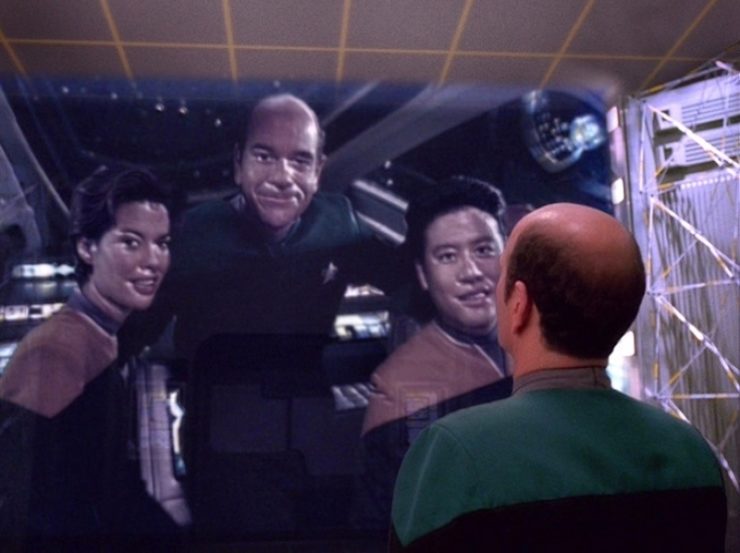
Seven discovers that the EMH does have memories from that time period, but he can no longer access them. She gets rid of the memory block, and he now recalls that there was a surprise birthday party in the mess hall for Ensign Ahni Jetal, who then went on a shuttle mission with Kim and the doctor, during which they were attacked.
Immediately, Seven and the EMH report to Janeway and Tuvok. The doctor worries that there’s an intruder on board who is erasing his memories, and who posed as an ensign on the ship. Tuvok and Janeway say they don’t recognize the alien in the holoimage Seven reconstructed, nor does Seven recognize them as a species the Borg has encountered. Janeway orders Seven to scan for cloaked ships, for Tuvok to run a security sweep, and for the EMH to deactivate himself until they can find out what’s going on.
The EMH agrees, returning to sickbay and removing his mobile emitter, but before he deactivates himself, he instructs the computer to make a copy of his memories from the prior 48 hours. If his program is tampered with in any way, he is to be reactivated, those memories restored. He also sets the holoimager on automatic, to take pictures every five seconds.
Sure enough, he’s reactivated, initially confused, then the computer restores his memory. Angry, he checks the holoimager to discover that the person who erased his memories of the last 48 hours was Janeway.
He goes to the bridge, interrupting a friendly argument among Janeway, Chakotay, and Tuvok about a sumo wrestling match to accuse Janeway of a horrific violation of his very self.
Janeway takes the conversation into the ready room. She had his memory of the incident with Jetal erased, as well as all memory of Jetal, because the incident caused a conflict in his programming that they could not resolve. Erasing his memory was the only viable solution, and she’d do it again in a heartbeat. She then orders the EMH to deactivate so that Torres can, again, rewrite his program to remove the conflict in question. Paris is briefed on all the experiments he’s currently running and whatever medical issues there might be. Paris also reassures the doctor that Janeway is doing the right thing, which the EMH finds not at all reassuring.
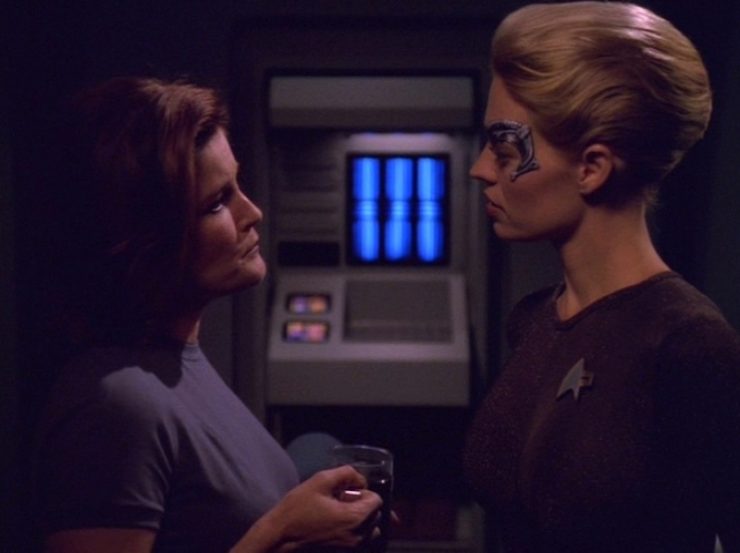
Seven goes to Janeway in her quarters, questioning her about the nature of individuality. Janeway analogizes the EMH to a replicator that needs to be repaired, but Seven reminds her that she is part machine, also, and she wonders if Janeway will treat Seven with the same disregard for her wishes if something similar happens. She also allows as how she may have picked the wrong person to be her mentor in how to be an individual as opposed to part of a collective.
Janeway, having been reminded that she’s a main character in a Star Trek series, reactivates the EMH and offers to tell him the whole story of what happened on Stardate 50979.
After Jetal’s surprise party, Kim, Jetal, and the EMH took a shuttle out, which was then attacked by aliens, one of whom boarded the ship and shot all three of them with a weapon. It didn’t affect the EMH, but both Kim and Jetal were badly injured. Voyager drove the aliens off with weapons fire, and the away team was beamed to sickbay. However, there was only one way to save them, and only the one doctor, and he can only save one of them, and the time it takes to save one will be a death sentence for the other one. He eventually chose Kim, and saved his life, but Jetal died while he operated.
Buy the Book
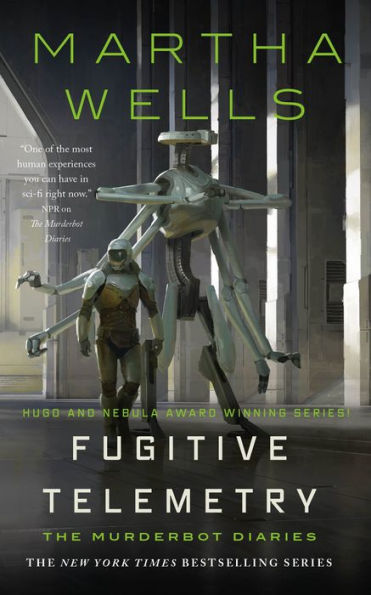

Fugitive Telemetry
The EMH suffered an existential crisis, having a complete meltdown in the mess hall, as his program was conflicted between his oath to do no harm and the fact that he chose one patient over another, one at least partly based on the fact that he knew Kim better and thought of him as a friend—a consideration that was never an issue with the original EMH program, but now the doctor has, in essence, a soul.
After being told this, he starts to have another meltdown in sickbay, and Janeway is forced to deactivate him. Torres is ready to rewrite his program again, since this is now the second time he’s thrown a nutty. But Janeway realizes that this is the wrong way to go. The EMH is a person, not just a program, and if it was anyone else in the crew, including a flesh-and-blood doctor, they would give him the opportunity to work through the issue.
So she reactivates him and makes sure someone is with him at all times while he sorts through the problem. After two weeks, he seems no closer. Janeway is sitting with him on the holodeck, reading Dante’s La Vita Nuova. She also falls asleep on him while he’s in the midst of soliloquizing, and the EMH belatedly realizes that, not only is she exhausted, but also feverish. He tells her to go to sickbay, but she says she’s too busy helping a friend. Touched, he insists, and says he’ll contact someone if he needs help. We fade out on him reading a passage from the book.
There’s coffee in that nebula! Despite making him officially chief medical officer, despite not having treated him like a replicator since the second season, Janeway acts as if the EMH is a piece of machinery rather than a member of the crew, at least until Seven whups her upside the head on the subject.
Half and half. Torres questions the notion of the EMH having a soul.
Everybody comes to Neelix’s. The EMH’s breakdown happens in the mess hall, and it’s Neelix who calls security on him, which only makes his fruit-throwing tantrum worse.
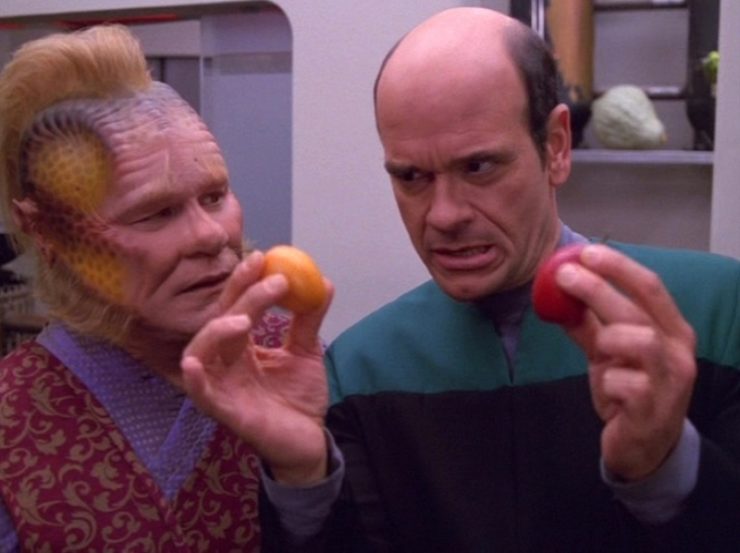
Resistance is futile. Seven wasn’t on board when Jetal died, so she isn’t aware of the coverup. As a result, she inadvertently leads the EMH to learning the truth, and it’s her reminding Janeway that the EMH is a sentient being with individual rights that gets them to treat him like a person with a psychological problem instead of a machine that needs to be repaired.
What happens on the holodeck stays on the holodeck. Apparently, holoimages leave behind photonic residue that can be used to partly re-create holographic images even after they’re deleted.
Do it.
“The primordial atom burst, sending out its radiation, setting everything in motion. One particle collides with another, gases expand, planets contract, and before you know it, we’ve got starships and holodecks and chicken soup. In fact, you can’t help but have starships and holodecks and chicken soup, because it was all determined twenty billion years ago!”
“There is a certain logic to your logic.”
–The EMH ranting and Tuvok providing commentary.
Welcome aboard. Nancy Bell plays Jetal, while Scarlett Pomers is back as Naomi.
Trivial matters: Jetal was originally the name given to the Betazoid on board in “Counterpoint,” but it was changed to Jurot, and the name was recycled here.
While this is the first time we’ve seen the EMH’s holoimager directly, we’ve seen the fruits of its labors in “Nothing Human” when the EMH was torturing the crew with his slideshows.
In the post-Nemesis Trek novels, Janeway was killed in the TNG novel Before Dishonor by Peter David, but later resurrected in the Voyager novel The Eternal Tide by Kirsten Beyer. When Janeway returns, the EMH quizzes her about the conversations the two shared in this episode by way of testing to see if it’s the real Janeway.
Joe Menosky’s first draft of the script had Janeway fall asleep while sitting with the EMH, but the doctor doesn’t wake her or send her off to sickbay, but picks up the book and reads it. Brannon Braga rewrote the scene as it was filmed, which disappointed both Menosky and most of the cast, who preferred the original draft.
The stardate given for Jetal’s death places that event between “Worst Case Scenario” and “Scorpion.”
The revelation that Jetal died toward the end of the third season means that there are now twenty confirmed deaths since they left the Ocampa homeworld, plus an unspecified number who died in “The Killing Game, Part II.” “In the Flesh” gave the crew complement as 128, and they had 155 at the end of “Caretaker” (the 152 Janeway mentioned in “The 37’s,” plus Seska, who left, Durst, who died, and the EMH, whom she wouldn’t have counted at the time). With the twenty confirmed deaths, that means that it is likely that seven people died fighting the Hirogen.
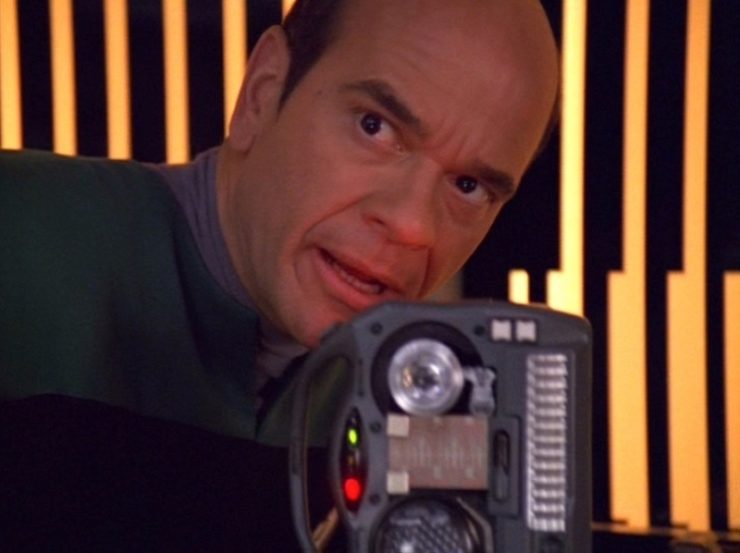
Set a course for home. “Here begins a new life.” This is almost a perfect episode. It’s hard to go wrong focusing an episode on Robert Picardo’s EMH (though they have managed it), and he delivers one of his strongest performances here. For the first time, Lewis Zimmerman’s snottiness is used to good effect, through the EMH’s righteous anger at being violated. And then, when he learns what he’s done, the doctor’s existential angst is magnificently played by Picardo.
There are so many clichés being turned on their ear here, starting with one of the oldest tropes in Trek’s playbook: human fallacy confusing the crap out of a machine, causing it to self-destruct. The ethical conundrum the EMH faces here is just like the ones foisted by Kirk upon Landru in “The Return of the Archons,” the androids in “I, Mudd,” and Nomad in “The Changeling.” And Janeway is forced to shut him down before he goes the way of those mechanical beings.
My favorite, though, is that this script takes one of my least favorite aspects of dramatic fiction in general: deaths of important characters are treated differently and with more reverence than deaths of side characters. More than twenty members of Voyager’s crew have died since they went into the Badlands to chase Chakotay’s Maquis cell, and those deaths have had absolutely no long-term impact on the rest of the crew. Most of them haven’t even had a short-term impact, and a lot of them didn’t even have names. Hell, we’ve only seen two memorial services (one of them in this episode, the other in “Alliances“).
The horrible choice the EMH must make puts this tendency in sharp relief. Harry Kim is in the opening credits. Ahni Jetal is a one-shot guest star. Of course Kim must live and Jetal must die and be forgotten—but this episode makes use of that tendency as a plot point, and it makes the story much more profound than it might be. The EMH considers Kim a friend, while Jetal is someone he only knows as a (very) occasional patient. And the fact that he favored Kim over Jetal haunts him, because it’s contrary to the objectivity and dispassion that he was originally programmed with as what was supposed to be an occasional medical supplement, not a full-time physician. Kim shouldn’t matter more than Jetal.
And that’s the other thing: the EMH isn’t just a machine, isn’t just a program, not anymore. As Janeway so eloquently puts it, they gave him a soul. He’s a person, and when a person has a psychological problem, they work through it. And Janeway belatedly realizes that that’s how she needs to treat this member of her crew—not as a replicator, but as a chief medical officer.
Which leads nicely to why this is not quite a perfect episode: Jetal’s death occurred eighteen months previous, before Seven joined the crew. This is an important plot point, as Seven’s ignorance of the subsequent coverup is what enables the EMH to realize that something is amiss. But there are several problems this brings up. One is that the flashbacks show Janeway and Paris with the same hair they have now, but both had significantly different hairstyles at the end of season three. (At least they remembered to put the hollow pip back on Paris’s collar in the flashback.)
The big one though is that we see Paris assisting the EMH with the medical procedure, and this raises the rather important question: where’s Kes?
This isn’t just an issue with the medical procedure, but also its aftermath. Of everyone on board Voyager, Kes was the one who routinely advocated for the EMH as a person rather than a program. That advocacy is the primary reasons why Janeway now (mostly) treats the EMH like the actual CMO instead of a tool.
And I can’t imagine any circumstance under which Kes would sit quietly and be okay with Janeway wiping the EMH’s memory like that. The role that Seven plays in the present-day portions of this episode is the exact same one (making some of the same arguments even) that Kes would have played in the flashback portion, if the writers had bothered to remember that she was even there.
This is still a powerful episode, one that has Trek’s trademark of examining the human condition through non-human characters (in this case, both the EMH and Seven), and uses one of TV’s most tired tropes as a brilliant plot point. And its only flaw is another tired trope, that of forgetting one’s own fictional history…
Warp factor rating: 9
Keith R.A. DeCandido is still doing his “KRAD COVID readings” YouTube channel but for 2021 he’s reading all his Star Trek: Starfleet Corps of Engineers novellas in weekly installments. This week, he’ll finish off his four-part reading of Cold Fusion, an S.C.E./Deep Space Nine crossover story in which the crew of the U.S.S. da Vinci team up with Lieutenant Nog to salvage Empok Nor.










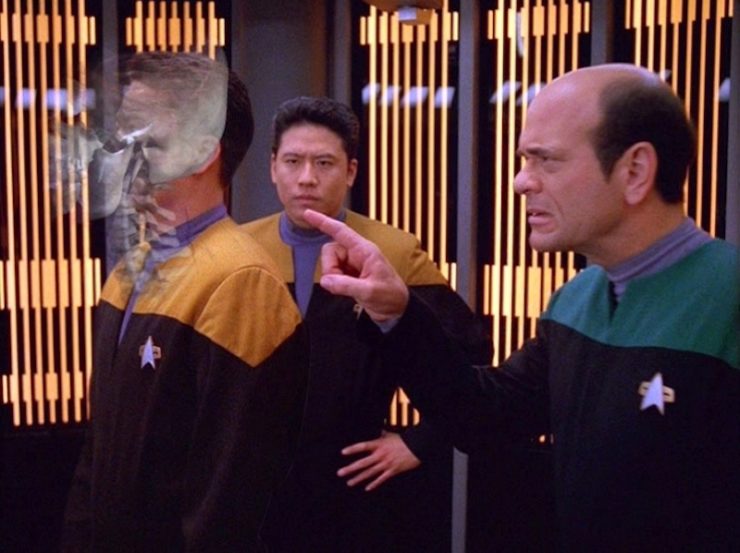
A fun episode. Too bad they never brought Omet’iklan back. And yeah, having part of the station blown off is a big deal. Guess they have spare pylons lying around for just such an occasion.
What costs the episode a higher rating (though not by much) is the fact thata friggin piece of the station was blown clean off, and after the beginning of Act 1, it’s totally forgotten about. That’s kind of a big deal, and sets the episode up for something other than what it is.
Truth be told, this isn’t as bad as what happened on Voyager’s second season, right around the same time as this episode, where the ship was crippled beyond repair, with major hull breaches.
Even with the ship stranded in the Delta Quadrant, all they had was Janeway delivering a log entry with the phrase: “repairs are continuing”. Now, that was a slap in the face of intelligent viewers.
At least, DS9 has Bajoran and Federation support to conduct timely repairs.
Having said that, I’m surprised To the Death held up this well. Although very violent, it turned out very thoughtful and entertaining.
It’s interesting just how well Behr and Wolfe balance character moments with plot and action. This episode is a prime example of that.
No offense to Ron Moore, but this is the reason why those two were the heart and soul of DS9 for so many years, the Lennon and McCartney of the DS9 writing staff.
You don’t have to be a mythological expert. You don’t have to strictly adhere to Roddenberry’s Box. You don’t have to deliver a human condition message every week. All you have to do is explore these characters in meaningful and entertaining ways (and occasionally pay homage to some golden-age Hollywood movies, the way Ira often tended to do).
And if the actors deliver, the way Combs did, all the better.
Yeah, it’s frustrating that the destruction of a major part of the station was ignored after that, and everything was back to normal the following week. It should’ve taken a month or two to rebuild that pylon. Of course, the problem is that the episodes weren’t necessarily aired in production order. This episode aired the week before “The Quickening,” but was produced the week after it. So it’s debatable whether the next episode in the sequence would be “The Quickening” or “Body Parts.”
Although for what it’s worth, both those episodes take up a lot of time; “The Quickening” spans nearly a month, and “Body Parts” begins after Quark returns from a 2-week vacation (and there’s no episode he’s entirely missing from, though he’s only glimpsed in the beginning of this one). So the pylon could be undergoing reconstruction in either of those episodes, or both if you put this one first. For what it’s worth, the only station exteriors we see in “The Quickening” are closeups on the central portions of the station, with the pylons unseen. But the opening shot of “Body Parts” is of the full, intact station. So in airdate order, there’s a gap of at least six weeks between the destruction of the pylon and our next glimpse of the intact station. Could that be why they inverted the episode order? To implicitly allow time for the pylon reconstruction?
This one does do a good job of fleshing out the Jem’Hadar, but it doesn’t make me think all that highly of them. I don’t respect anyone who deals or embraces death so casually. Killing anyone in your group who makes a mistake is stupid, because the only way to gain experience and wisdom is by learning from one’s mistakes. If every soldier is killed at the first major error, then the entire unit will be made up of inexperienced or overconfident members. So I have to disagree with you, Keith — it doesn’t make the Jem’Hadar look scarier, it makes them look less competent.
Or, as George C. Scott said in Patton, “I want you to remember that no bastard ever won a war by dying for his country. He won it by making the other poor, dumb bastard die for his country.” The Jem’Hadar are pathologically eager to die for their country, which puts them at a major disadvantage compared to Starfleet officers, who — while not eager to make others die as an end in itself — are dedicated to living for their country, to remaining intact so that they can contribute meaningfully to the cause, rather than just rushing into destruction and casually reducing their own numbers.
Of course, that’s a function of the Jem’Hadar being bred as cannon fodder by a Dominion that has no respect for them as individuals. So it’s understandable why they think that way even though it’s against their best interests. But it shows a lack of judgment on the Founders’ part. Their fundamental contempt for “solids” gives them a blind spot, because it makes them treat the Jem’Hadar more like munitions than people.
Still, in retrospect, it’s remarkable how critical this one episode was to fleshing out so much about the Dominion. It established so much about J’H culture, it confirmed who the Vorta are, and it introduced Weyoun. Surprising, really, since plotwise it feels like kind of a standalone, a situation that was never really followed up on.
And it’s kind of a waste that the one time TV Trek revisited the Iconians, it was as nothing more than a McGuffin in an episode about something entirely different. Yes, it’s marginally better than bringing in yet another ancient alien race, but two references aren’t much better than one. I often get frustrated that the Trek universe is so broad and shallow in its treatment of aliens, constantly bringing in new species and worlds rather than fleshing out ones mentioned in the past. It’s a great deal of wasted potential and it makes the universe overly cluttered — although it has given me and a lot of my Trek-novelist peers (Keith included) plenty of material to expand on.
Although the books haven’t done that much with the Iconians either. They were more of a background element in Gateways even though their artifacts were more central. And aside from that, they only featured in one earlier novel, The Devil’s Heart by Carmen Carter (which approached them differently than Gateways did). I think they’ve been used in a significant way in Star Trek Online, but I don’t follow the game.
So…..hows that blockade of the wormhole coming Sisko? Is it still not worth using the incredible strategic asset you enjoy… ok. And you are taking the Defiant away on AQ excursions now? Even though its original stated aim was to protect against a Dominion attack….ok.
Yap, no-one could have forseen anything like this occuring. An attack through that incredibly easy to block chokepoint. Carry on Sisko. Carry on.
@@.-@: As I keep pointing out, the Dominion is not the only thing on the other side of the wormhole. There are plenty of other worlds there that have trade partnerships with AQ powers and plenty of resources for AQ explorers to seek out. The wormhole is a major trade and shipping route that’s vital to the region’s economic strength and particularly to Bajor’s. You can’t just choke it off without hurting Bajor and the Federation.
In Star Trek Online, the Iconians have been used as an enemy of the Federation (and of the Klingons and Romulans as well).
@3, Their fundamental contempt for “solids” gives them a blind spot, because it makes them treat the Jem’Hadar more like munitions than people.
I still love how that blind spot, while a stregnth in the Gamma Quadrant, ends up being critical to the resolution of the Dominion War.
#5
Exactly. It would be like closing the Panama Canal. It’s a major thoroughfare.
Definitely a solid episode and the clear highlight is Jeffrey Combs. He plays the Weyouns absolutely perfectly, just the right amount of slime, smarm, and steel. Even when we get a Weyoun who breaks from his programming later, he’s absolutely a believable variation of the type.
I suppose the destruction of the upper pylon was meant to show that the Jem’Hadar are extremely badass and dangerous. But as everybody has noted, it’s handled poorly (including a throwaway line about Rom).
So…the crew should not at least attempt the bare minimum of wormhole security. Such at least having some sort of emergency minefield activation or some such in case an enemy fighter appears? An opposing power that has designs on the AQ? Its reaching and (will surpass in season 5) absurd levels of stupidity. I’m sure a cursory google search will at least return the juxtipation of Panama Canal+ security.